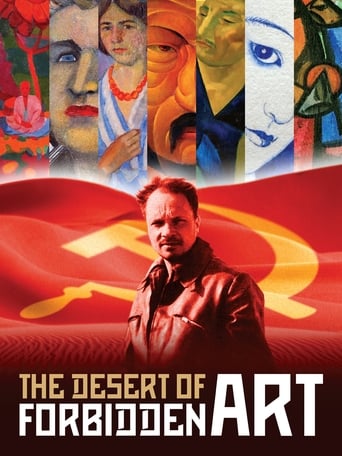

This review was made following a screening at Cambridge Film Festival (September 2011): This documentary's content left me feeling that, despite talking about Stalin's propaganda, it was a sort of propaganda in itself, very much in the style of Schindler's List. A polarisation of that kind must tend to mask the true picture.The film told how Savitsky worked on his paintings during breaks from archaeological digs, but it was far from clear how a more eminent painter's demolition of these works left him with still the confidence to judge merit in the art world, and so begin collecting what he thought worthwhile, whereas he had believed the criticism and destroyed his own art.I am afraid that I just do not buy this idea that there were any clear rights or wrongs in all this. We were told that one artist was denounced by another, and that this was not known to his own sons until they were shot on camera reacting to (what were said to be) official files in which, in transcripts of interviews, he identified that artist's anti-Soviet attitudes.Yet the sons somehow participated until that point without any knowledge of their father's trying to save his skin by 'co-operating' in this way (ultimately unsuccessfully, since he was denounced in his turn). (He had represented those working on projects such as irrigation channels, in which there would inevitably have been forced labour and a death-toll, as Soviet ideals, but the images were turned against him as uglifying USSR's citizens.) Other things just did not ring true: the whole way in which Savitsky was supposed to have used influence to get funding both to establish his museum and pay for exhibits for it made no sense, and was utterly implausible; likewise, his collecting works and taking them (and how he took them) to Nukus without any official troubling about it; and, for me, the entire hagiography surrounding him, his life and death, which the glowingly anti-USSR US journalist seemed to want to accept for the wrong reasons.In addition, that speaker seemed to have no notion that it was hypocritical in the extreme to blame a Soviet regime for ruining the Aral Sea's ecology, as if his country's energy policy is blameless, and such willingness to believe a black-and-white picture seemed naive. In that vein, we were told, without explanation, that a female artist's work depicting Soviet labour camps had not only survived unscathed, but asked to credit that Savitsky had cleverly passed it off as depicting Nazi camps.A minor irritation was also not easily working out who was who - some speakers were introduced, but only identified, and to be told that someone on screen was the artist X's son when it was not clear who X was also didn't help. In addition, to have the two sons talking about what Savitsky did in relation to the artists (or relatives from whom he acquired works) just reinforced one's uncertainty as to both how they would have known this, and whether, at any given time, they had started talking about their artist father or Savitsky.
... View MoreThis is an amazing film about hidden treasure that is so vulnerable. I hope that something can be done to save this art and bring it to the world. The paintings are so vivid; I will never forget them.I went to the website: "desertofforbiddenart.com" and immediately made a contribution to the book of paintings being planned. It is ironic, that after so many years of hiding the works from Stalin, it is now, in the twenty-first century, that the paintings are in the most danger.But it is not only viewing the paintings that made such an impression on me, but the stories of the forgotten artists. The world should know who they were, and the incredible sacrifices they made to be painters.
... View MoreIn the midst of a totalitarian dictatorship, an eccentric man risks his life and uses his wiles to save what he values far more than his society does. What, you mean you've already seen "Schindler's List?!" But what if, instead of saving people, the man just saved art - tons and tons of splendid art?This amazing story, with characters as wild and bizarre and wonderful as any you'll see in any flick, is terrifying, heartwarming, funny, and hugely human. Even if you're not an art-lover, this tale tells so much about our times, there's no way to not be moved. It's both a good and bad thing that this came out in a time when there were so many important and excellent documentaries that this got ignored by the Oscars. It's a movie for everyone - take your grandmother and your kids. Cannot recommend it enough.
... View MoreNo art history degree is required - this movie is story of the person, portrait of epoch - distant and the current one. Cinematographicaly the movie is very well shot, it is well researched - never seen materials from Russia's Krasnogorsk film archives are used. Quite unusual but completely on the point is the citation from the cult Russian movie "White Sun of the Desert" (1970) http://www.imdb.com/title/tt0066565/. The movie is not trying to depict the Soviet era as 70 years of horrors - it rather shows that it's up to individual to find his/her way while being artistically (as I.Savitsky himself) or politically rejected.The editing of this movie is done more in line with Russian film-making tradition - which makes viewer to be much more emotionally involved then your standard History channel movie.Overall it's rare case when we have a worthy subject, the passionate filmmakers and the best intentions of the authors of the movie are perfectly aligned with their capabilities to deliver.
... View More